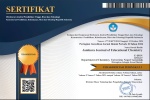Profil Pemahaman Konsep Hidrolisis Garam: Studi Pada Siswa SMA di Jawa Timur
Abstract
Keywords
Full Text:
PDFReferences
Amala, F., & Habiddin, H. (2022). Pemahaman Konsep dalam Topik Sifat Asam Basa larutan Garam: Studi pada Siswa SMA di Blitar. Jurnal Zarah, 10(2), 91-100. https://doi.org/10.31629/ZARAH.V10I2.4321
Aquirre-Ode, F. (1987). A general approach for teaching hydrolysis of salts. Journal of Chemical Education, 64(11), 957. https://doi.org/10.1021/ed064p957
Ardina, D., & Habiddin, H. (2023). Acid-base properties of salt solution: Study at a secondary school in Banyuwangi. AIP Conference Proceedings, 2569(1), 30018. https://doi.org/10.1063/5.0112074
Erna, M., Anwar, L., & Mazidah, M. (2021). Interactive e-module using Zoom Cloud Meeting platform to reduce misconceptions on salt hydrolysis material. Journal of Education and Learning (EduLearn), 15(2), 283-290. https://doi.org/https://doi.org/10.11591/edulearn.v15i2.18460
Fauzizah, U., Nurhayati, N. D., & Masykuri, M. (2022). The Relationship Between Self-Regulated Learning and Technology Literacy With Conceptual Understanding of Salt Hydrolysis. J-PEK (Jurnal Pembelajaran Kimia), 7(2), 99-107. https://doi.org/10.17977/UM026V7I22022P099
Febriani, G., Marfu'ah, S., & Joharmawan, R. (2018). Identifikasi Konsep Sukar, Kesalahan Konsep, dan Faktor-Faktor Penyebab Kesulitan Belajar Hidrolisis Garam Siswa Salah Satu SMA Blitar. J-PEK (Jurnal Pembelajaran Kimia), 3(2), 35-43.
Habiddin, H., Akbar, D. F. K., Husniah, I., & Luna, P. (2022a). Descubriendo la comprensión de los estudiantes: Evidencia para la enseñanza de las propiedades ácido-base de la solución salina. Educación QuÃmica, 33(1), 64-76. https://doi.org/10.22201/FQ.18708404E.2022.1.79488
Habiddin, H., Akbar, D. F. K., Husniah, I., & Luna, P. (2022b). Uncovering Students' Understanding: Evidence For The Teaching of Acid-Base Properties of Salt Solution. Educación QuÃmica, 33(1), 64-76. https://doi.org/10.22201/FQ.18708404E.2022.1.79488
Habiddin, H., Ameliana, D. N., & Su'aidy, M. (2020). Development of a Four-Tier Instrument of Acid-Base properties of salt Solution. JCER (Journal of Chemistry Education Research), 4(1), 51-57. https://doi.org/10.26740/jcer.v4n1.p51-57
Habiddin, H., Atikah, A., Husniah, I., Haetami, A., & Maysara, M. (2021). Building scientific explanation: A study of acid-base properties of salt solution. AIP Conference Proceedings, 2330(1), 20047. https://doi.org/10.1063/5.0043215
Habiddin, H., Mulyasari, D. I., Muchson, M., Hasan, H., Luna, P., Akbar, D. F. K., & Mustapa, K. (2021). Are students aware of their scientific conceptions? AIP Conference Proceedings, 2331(1), 40007. https://doi.org/10.1063/5.0041634
Habiddin, H., & Page, E. M. (2019). Development and validation of a four-tier diagnostic instrument for chemical kinetics (FTDICK). Indonesian Journal of Chemistry, 19(3), 720-736. https://doi.org/10.22146/ijc.39218
Hidayah, U. L., Supardi, K. I., & Sumarni, W. (2018). Penggunaan Instrumen Lembar Wawancara Pendukung Tes Diagnostik Pendeteksi Miskonsepsi Untuk Analisis Pemahaman Konsep Buffer-Hidrolisis. Jurnal Inovasi Pendidikan Kimia, 12(1), 2075-2085.
https://journal.unnes.ac.id/nju/index.php/JIPK/article/view/13299
Holme, T. A., Luxford, C. J., & Brandriet, A. (2015). Defining Conceptual Understanding in General Chemistry. Journal of Chemical Education, 92(9), 1477-1483. https://doi.org/10.1021/acs.jchemed.5b00218
Husniah, I., Habiddin, H., Sua'idy, M., & Nuryono, N. (2019). Validating an instrument to investigate students' conception of Salt hydrolysis. Journal of Disruptive Learning Innovation (JODLI), 1(1), 1-6.
Irawati, R. K. (2019). Pengaruh Pemahaman Konsep Asam Basa terhadap Konsep Hidrolisis Garam Mata Pelajaran Kimia SMA Kelas XI. Thabiea : Journal of Natural Science Teaching, 2(1), 1-6. https://doi.org/http://dx.doi.org/10.21043/thabiea.v2i1.4090
Jin, H., & Wong, K. Y. (2015). Mapping conceptual understanding of algebraic concepts: an exploratory investigation involving grade 8 Chinese students. International Journal of Science and Mathematics Education, 13(3), 683-703. https://doi.org/10.1007/s10763-013-9500-2
Laliyo, L. A. R., La Kilo, A., Paputungan, M., Kunusa, W. R., Dama, L., & Panigoro, C. (2022). Rasch modelling to evaluate reasoning difficulties, changes of responses, and item misconception pattern of hydrolysis. Journal of Baltic Science Education, 21(5), 817-835. https://doi.org/https://doi.org/10.33225/jbse/22.21.817
Nimmermark, A., Ohrstrom, L., Martensson, J., & Davidowitz, B. (2016). Teaching of chemical bonding: a study of Swedish and South African students' conceptions of bonding. Chemistry Education Research and Practice. http://dx.doi.org/10.1039/C6RP00106H
Nusi, K., Laliyo, L. A. R., Suleman, N., & Abdullah, R. (2021). Deskripsi Pemahaman Konseptual Siswa pada Materi Hidrolisis Garam. QUANTUM: Jurnal Inovasi Pendidikan Sains, 12(1), 118-127. https://doi.org/http://dx.doi.org/10.20527/quantum.v12i1.9228
Putri, A. K., Afandy, D., & Su'aidy, M. (2016). Pengaruh Penerapan Strategi Pembelajaran Praktikum Menggunakan Diagram Ve Terhadap Hasil Belajar Siswa Pada Materi Hidrolisis Garam. J-PEK (Jurnal Pembelajaran Kimia), 1(2), 15-18.
Romine, W. L., Todd, A. N., & Clark, T. B. (2016). How Do Undergraduate Students Conceptualize Acid-Base Chemistry? Measurement of a Concept Progression. Science Education, 100(6), 1150-1183. https://doi.org/10.1002/sce.21240
Stevens, S. Y., Delgado, C., & Krajcik, J. S. (2010). Developing a hypothetical multi-dimensional learning progression for the nature of matter. Journal of Research in Science Teaching, 47(6), 687-715. https://doi.org/https://doi.org/10.1002/tea.20324
Yakubi, M., Hanum, L., & Zulfadli. (2017). Menganalisis Tingkat Pemahaman Siswa pada Materi Ikatan Kimia Menggunakan Instrumen Penilaian Four-Tier Multiple Choice ( Studi Kasus pada Siswa Kelas X SMA Negeri 4 Banda Aceh ). Jurnal Ilmiah Mahasiswa Pendidikan Kimia, 2(1), 19-26.
Yaman, F., & Ayas, A. (2015). Assessing changes in high school students' conceptual understanding through concept maps before and after the computer-based predict-observe-explain (CB-POE) tasks on acid-base chemistry at the secondary level. Chemistry Education Research and Practice, 16(4), 843-855. https://doi.org/10.1039/C5RP00088B
DOI: https://doi.org/10.34312/jjec.v5i1.19305
Refbacks
- There are currently no refbacks.
Editorial Office

|
Department of Chemistry, Universitas Negeri Gorontalo |

|
E-mail: [email protected] |

|
|

|
Jambura Journal of Educational Chemistry (p-ISSN: 2655-7606 | e-ISSN: 2656-6427) by Department of Chemistry Universitas Negeri Gorontalo. This work is licensed under a Creative Commons Attribution 4.0 International License. Powered by Public Knowledge Project OJS |










